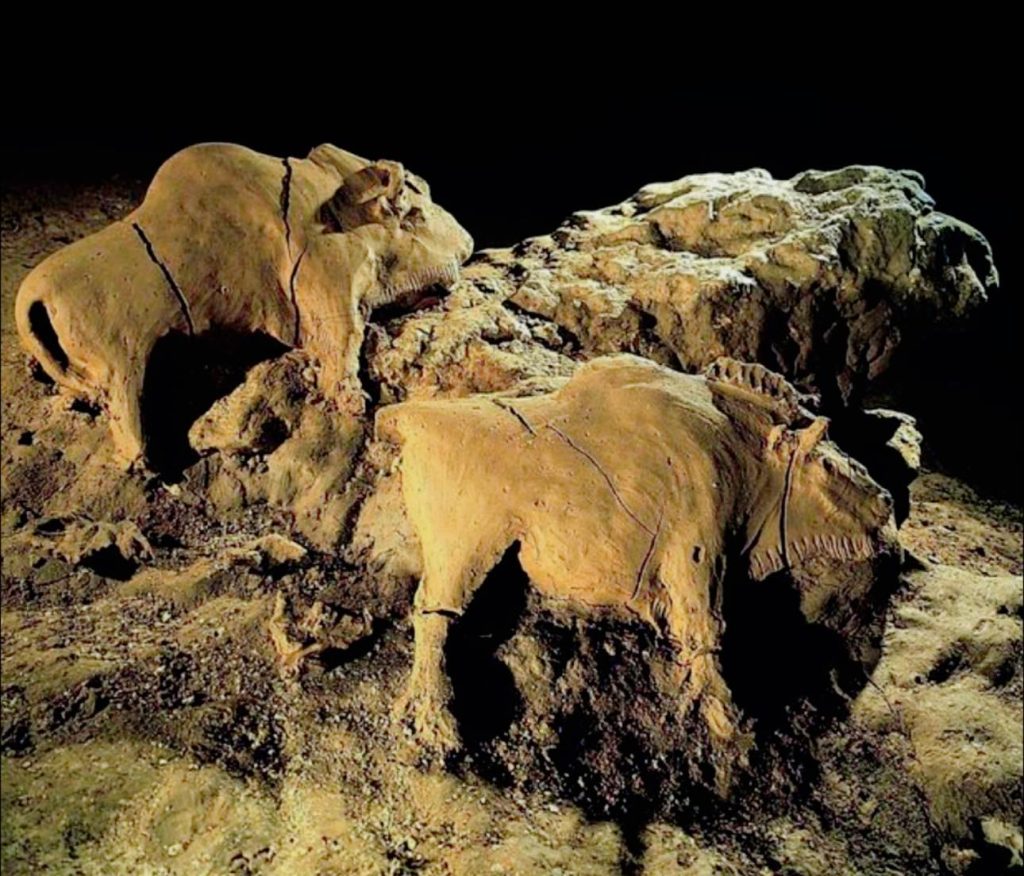Deep within the shadowy chambers of the Tuc d’Audoubert caves in France lies a profound and timeless expression of human creativity—two magnificent clay sculptures of bison, created approximately 15,000 years ago. These ancient works of art, shaped by our prehistoric ancestors, continue to astonish modern scholars and visitors alike, not just for their physical form, but for the mystery and spirit they carry across millennia. Carved from the very clay of the cave walls, these figures remain untouched by the chaos of time, quietly resting in darkness, yet glowing with meaning for anyone fortunate enough to glimpse them.

Each sculpture stands around 18 inches tall and stretches roughly 24 inches in length, yet despite their relatively modest size, their artistic impact is immense. The level of detail and expression embedded in the bison is astonishing, suggesting a deep reverence and understanding of these animals. Every curve and contour reflects the sculptor’s close observation of the natural world and a profound connection to it. What makes these sculptures all the more fascinating is the fact that they were made using only simple tools—or in some cases, perhaps just human hands. Imprints from fingers can still be traced on their surfaces, creating an eerie and intimate connection between modern observers and the unknown artists who worked in the cave so long ago.
Many archaeologists and scholars have studied the bison, proposing a variety of theories about their purpose. Were they part of a sacred ritual? Could they have symbolized fertility, or perhaps a successful hunt? Some experts believe they were used in rites of passage, while others suggest that they represented totemic animals or spiritual guides. The truth is, we may never know exactly what these figures meant to the people who made them. The world in which these artists lived was vastly different from our own—one where survival depended on nature and community, and where art may have held spiritual, practical, or emotional value that cannot be fully grasped today.
Yet it is precisely this mystery that lends the bison such power. Their meaning may be lost, but their presence is undeniable. Standing in silent splendor, they speak a universal language of creativity and expression that resonates with us regardless of time or place. These sculptures remind us that art has always been an essential part of being human—not a luxury or distraction, but a fundamental way of understanding the world and our place in it.
The location of the bison sculptures, buried deep in a cave that is not open to the general public, adds to their mystique. Visitors cannot approach them closely, and access is strictly limited to preserve their delicate condition. Yet just knowing they exist is enough to stir the imagination. In a modern world where so much of our environment is shaped by technology and speed, the bison invite us to slow down, to reflect, and to consider the lives of those who came before us. They prompt questions that may never be answered but are worth asking nonetheless—What did our ancestors think about as they molded these animals? What feelings did they hope to capture? Did they consider themselves artists in the way we understand the term today?
The sculptures also offer a profound lesson about legacy. The individuals who shaped these bison never imagined that their work would survive thousands of years, or that it would be studied by scientists and admired by people from all over the world. And yet, here they are, perfectly preserved in clay and spirit. Their creators may be long forgotten, but their hands speak through the centuries, reminding us that what we create today can echo far into the future.
More than relics of the past, the Tuc d’Audoubert bison serve as a mirror, reflecting our own desires for meaning, connection, and beauty. They challenge us to think about how we express ourselves, how we relate to nature, and how we remember those who came before. They suggest that while civilizations may rise and fall, the impulse to create—to give form to emotion and thought through art—is something deeply embedded in the human soul.
There is something profoundly moving about the fact that even in the harsh, uncertain world of the Ice Age, humans still found time to make art. It tells us that creativity is not simply about aesthetics or decoration, but about survival in a deeper sense. Art helps us process our experiences, celebrate what matters, and leave something behind that says “I was here, and I felt something.” In this way, the bison of Tuc d’Audoubert are more than just sculptures—they are messages in a bottle from the distant past, reminding us of our shared humanity.
As we stand at a distance from these ancient figures, unable to touch them but forever changed by their presence, we find ourselves connected to a lineage of creativity that stretches back tens of thousands of years. That connection, however intangible, is real. It is felt in the silence of the cave, in the light that glances off the clay, and in the stories we tell each other about what it means to be human. The bison are not only remnants of a prehistoric time—they are reminders that beauty, mystery, and the desire to create have always been with us and always will be.
Ultimately, the clay bison of Tuc d’Audoubert stand as eternal symbols of humanity’s artistic spirit—silent, enigmatic, and deeply moving. Their origins may be lost to time, but their message endures: that through art, we reach across ages, across cultures, and across the unknown, forever seeking to understand ourselves and one another. In their stillness, they continue to speak.





